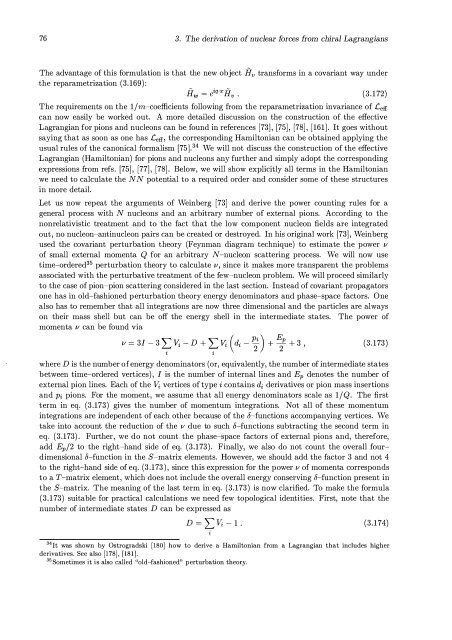The Nucleon-Nucleon Interaction in a Chiral Effective Field Theory
The Nucleon-Nucleon Interaction in a Chiral Effective Field Theory
The Nucleon-Nucleon Interaction in a Chiral Effective Field Theory
Create successful ePaper yourself
Turn your PDF publications into a flip-book with our unique Google optimized e-Paper software.
76 3. <strong>The</strong> derivation of nuclear forces from chiral Lagrangians<br />
<strong>The</strong> advantage of this formulation is that the new object Hv transforms <strong>in</strong> a covariant way under<br />
the reparametrization (3.169):<br />
H- w - eiq'xHv<br />
· (3.172)<br />
<strong>The</strong> requirements on the l/m-coefficients follow<strong>in</strong>g from the reparametrization <strong>in</strong>variance of Leff<br />
can now easily be worked out. A more detailed discussion on the construction of the effective<br />
Lagrangian for pions and nucleons can be found <strong>in</strong> references [73], [75], [78], [161]. It goes without<br />
say<strong>in</strong>g that as soon as one has Leff, the correspond<strong>in</strong>g Hamiltonian can be obta<strong>in</strong>ed apply<strong>in</strong>g the<br />
usual rules of the canonical formalism [75].34 We will not discuss the construction of the effective<br />
Lagrangian (Hamiltonian) for pions and nucleons any furt her and simply adopt the correspond<strong>in</strong>g<br />
expressions from refs. [75], [77], [78]. Below, we will show explicitly all terms <strong>in</strong> the Hamiltonian<br />
we need to calculate the N N potential to a required order and consider some of these structures<br />
<strong>in</strong> more detail.<br />
Let us now repeat the arguments of We<strong>in</strong>berg [73] and derive the power count<strong>in</strong>g rules for a<br />
general process with N nucleons and an arbitrary number of extern al pions. Accord<strong>in</strong>g to the<br />
nonrelativistic treatment and to the fact that the low component nucleon fields are <strong>in</strong>tegrated<br />
out, no nucleon-ant<strong>in</strong>ucleon pairs can be created or destroyed. In his orig<strong>in</strong>al work [73], We<strong>in</strong>berg<br />
used the covariant perturbation theory (Feynman diagram technique) to estimate the power v<br />
of small external momenta Q for an arbitrary N-nucleon scatter<strong>in</strong>g process. We will now use<br />
time-ordered35 perturbation theory to calculate v, s<strong>in</strong>ce it makes more transparent the problems<br />
associated with the perturbative treatment of the few-nucleon problem. We will proceed similarly<br />
to the case of pion-pion scatter<strong>in</strong>g considered <strong>in</strong> the last section. Instead of covariant propagators<br />
one has <strong>in</strong> old-fashioned perturbation theory energy denom<strong>in</strong>ators and phase-space factors. One<br />
also has to remember that all <strong>in</strong>tegrations are now three dimensional and the particles are always<br />
on their mass shell but can be off the energy shell <strong>in</strong> the <strong>in</strong>termediate states. <strong>The</strong> power of<br />
momenta v can be found via<br />
L L ( Pi) Ep<br />
v = 31 - 3 11,. - D + v: d· - - + - . z . z Z<br />
+ 3<br />
(3.173)<br />
Z Z<br />
2 2<br />
where Dis the number of energy denom<strong>in</strong>ators (or, equivalently, the number of <strong>in</strong>termediate states<br />
between time-ordered vertices), 1 is the number of <strong>in</strong>ternal l<strong>in</strong>es and Ep denotes the number of<br />
external pion l<strong>in</strong>es. Each of the Vi vertices of type i conta<strong>in</strong>s di derivatives or pion mass <strong>in</strong>sertions<br />
and Pi pions. For the moment, we assurne that all energy denom<strong>in</strong>ators scale as l/Q. <strong>The</strong> first<br />
term <strong>in</strong> eq. (3.173) gives the number of moment um <strong>in</strong>tegrations. Not all of these momentum<br />
<strong>in</strong>tegrations are <strong>in</strong>dependent of each other because of the 6-functions accompany<strong>in</strong>g vertices. We<br />
take <strong>in</strong>to account the reduction of the v due to such 6-functions subtract<strong>in</strong>g the second term <strong>in</strong><br />
eq. (3.173). Further , we do not count the phase-space factors of external pions and, therefore,<br />
add Ep/2 to the right-hand side of eq. (3.173). F<strong>in</strong>ally, we also do not count the overall fourdimensional<br />
6-function <strong>in</strong> the S-matrix elements. However, we should add the factor 3 and not 4<br />
to the right-hand side of eq. (3.173), s<strong>in</strong>ce this expression for the power v of momenta corresponds<br />
to aT-matrix element, which does not <strong>in</strong>clude the overall energy conserv<strong>in</strong>g 6-function present <strong>in</strong><br />
the S-matrix. <strong>The</strong> mean<strong>in</strong>g of the last term <strong>in</strong> eq. (3.173) is now clarified. To make the formula<br />
(3.173) suitable for practical calculations we need few topological identities. First, note that the<br />
number of <strong>in</strong>termediate states D can be expressed as<br />
D=L Vi-l. (3.174)<br />
34 It was shown by Ostrogradski [180] how to derive a Hamiltonian from a Lagrangian that <strong>in</strong>cludes higher<br />
derivatives. See also [178], [181].<br />
35 Sometimes it is also called "old-fashioned" perturbation theory.<br />
'












